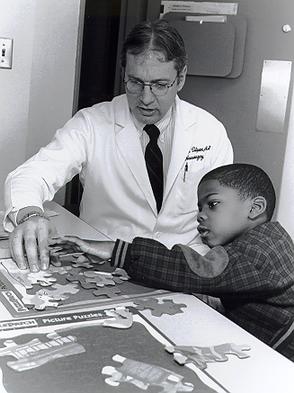Technique to ease spasticity shows promise in the long run

Dr. Noel Tulipan works with five-year-old patient Cody Noyes to put together a puzzle, a tade more difficult by spasticity.
A surgical technique that eases lower-limb spasticity in cerebral palsy patients is showing long-term success, Vanderbilt University Medical Center surgeons say.
The technique, called selective dorsal rhisotomy, involves cutting some groups of nerve fibers passing into the lower spinal cord. It allows cerebral palsy patients who could barely sit in a wheelchair or lie flat in a bed to regain some measure of mobility, said Dr. Noel B. Tulipan, associate professor of Neurosurgery.
"Some of these children can go from being confined to a wheelchair to walking."
Tulipan and Dr. Anthony W. Kilroy, associate professor of Neurology, work together to carry out the procedure here at VUMC. After nearly 40 dorsal rhisotomies, both say that it has been a great success, free of any severe complications and enabling many children to improve their conditions.
"Reducing the spasticity in the lower back also seems to improve function in the arms and hands, which is an added benefit," said Kilroy.
"The attractiveness of the dorsal rhisotomy is that it allows a surgeon to test each nerve rootlet before he cuts it at the time of the operation. That way the ones that need sectioning get sectioned and the ones that don't, don't."
VUMC is the only facility in Middle Tennessee that performs the dorsal rhisotomy procedure.
The main cause of lower limb spasticity associated with cerebral palsy is the inability of a muscle to control its own actions, leading to involuntary and excessive muscle contractions, or spasticity.
An undamaged brain and spinal cord inhibit spasticity by allowing only some signals to reach the limbs. However, when the brain and spinal cord are damaged, such as in cerebral palsy, there may be an excessive stream of signals to lower-limb muscles, resulting in varying amounts of excessive muscle tension.
The key to easing this uncontrollable spasticity is to identify which nerves are overloading the lower-limb muscles.
"Determining which nerve roots are damaged requires going in and testing each of the roots of the legs on both sides," said Tulipan.
The procedure itself lasts for about three hours. The surgeons first implant eight small electrodes into the muscles of the legs. These serve to monitor the electrical impulses that are sent to the leg muscles, causing spasticity.
"We use a special recording device that is able to sense the impulses in the muscles so we know which nerve roots are defective," said Tulipan.
Each of the nerve roots in the lower back are then teased out into rootlets. Tulipan and Kilroy then test approximately 50 of these rootlets to see which ones are sending impulses and over-stimulating the muscle.
"If we get a spastic response when we stimulate the rootlet then we cut it. If we don't, we leave it alone," said Tulipan.
"The children are in the hospital for 3-4 days and then there is some physical therapy afterwards that helps them to restore some of their movement," said Tulipan.













